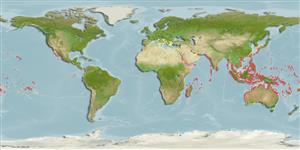Preferred temperature (Ref.
123201): 24.6 - 29.3, mean 28.4 °C (based on 3280 cells).
Phylogenetic diversity index (Ref.
82804): PD
50 = 0.5000 [Uniqueness, from 0.5 = low to 2.0 = high].
Bayesian length-weight: a=0.00257 (0.00115 - 0.00574), b=3.09 (2.91 - 3.27), in cm total length, based on LWR estimates for this Genus-body shape (Ref.
93245).
Trophic level (Ref.
69278): 3.5 ±0.48 se; based on food items.
Widerstandsfähigkeit (Ref.
120179): hoch, Verdopplung der Population dauert weniger als 15 Monate. (Preliminary K or Fecundity.).
Fishing Vulnerability (Ref.
59153): Moderate vulnerability (36 of 100).
Nutrients (Ref.
124155): Calcium = 209 [47, 470] mg/100g; Iron = 0.715 [0.260, 2.500] mg/100g; Protein = 18.2 [15.3, 20.6] %; Omega3 = 0.105 [0.048, 0.313] g/100g; Selenium = 21 [9, 55] μg/100g; VitaminA = 285 [74, 954] μg/100g; Zinc = 1.17 [0.47, 3.22] mg/100g (wet weight);
